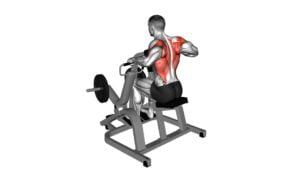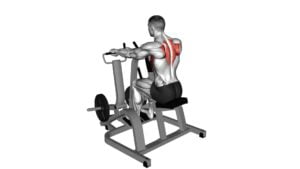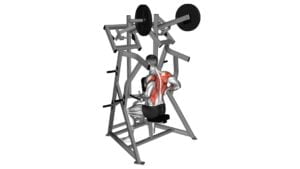Lever Pullover (Plate Loaded) – Video Exercise Guide & Tips

Are you ready to take your workout to the next level?
Watch This Exercise Video
In this video exercise guide, we'll show you how to master the Lever Pullover (Plate Loaded) exercise.
This versatile move targets your back and chest muscles, helping you build strength and definition.
With proper technique and form, along with variations and progressions, you'll be able to maximize the benefits of this exercise.
Get ready to sweat and see results with our expert tips and advice.
Let's get started!
Key Takeaways
- The lever pullover exercise targets upper body strength and stability.
- It improves chest, shoulders, and back muscles.
- The exercise is time-efficient and offers various variations for added challenge.
- Proper technique and form, such as maintaining a stable position and engaging the core, are crucial for maximizing the benefits of the lever pullover.
Benefits of the Lever Pullover Exercise
The Lever Pullover exercise offers several benefits for your upper body strength and stability. By incorporating this exercise into your routine, you can expect to see improvements in your chest, shoulders, and back muscles. The primary benefit of the Lever Pullover is its ability to target multiple muscle groups simultaneously, making it a time-efficient exercise option. Additionally, this exercise helps increase your range of motion and flexibility in the upper body.
There are various variations of the Lever Pullover that you can try to add variety to your workouts. One option is to use different types of equipment such as dumbbells, barbells, or resistance bands. You can also modify the exercise by changing the angle of the bench or adjusting the weight load. These variations can help target specific muscle groups or add an extra challenge to your workout routine.
Now that you understand the benefits and variations of the Lever Pullover exercise, let's move on to discussing the proper technique and form for this exercise.
Proper Technique and Form for the Lever Pullover
To perform the Lever Pullover exercise with proper technique and form, it's important to maintain a strong and stable position throughout the movement.
Begin by sitting on the lever pullover machine with your back flat against the pad and your feet planted firmly on the ground. Grasp the handles with an overhand grip and extend your arms straight in front of you.
As you begin the exercise, slowly lower your arms behind your head while keeping your elbows slightly bent. Make sure to engage your core and keep your back pressed against the pad to maintain stability.
To maximize muscle activation, focus on using your chest and back muscles to control the movement. Avoid using momentum or swinging your body to complete the exercise.
If you find it challenging to maintain proper form, you can make modifications by using lighter weights or adjusting the seat position to accommodate your range of motion.
Variations and Progressions for the Lever Pullover
Try incorporating different grip variations for added challenge and muscle engagement in your Lever Pullover exercise. By modifying your grip, you can target different muscle groups and increase the difficulty of the exercise.
One variation you can try is using an underhand grip, where your palms face up towards the ceiling. This grip places more emphasis on your biceps and upper back muscles.
Another variation is the overhand grip, where your palms face down towards the floor. This grip primarily works your triceps and chest muscles.
You can also experiment with a wide grip or a close grip, which will further alter the muscle groups targeted during the exercise.
Additionally, you can progress the Lever Pullover by increasing the weight on the lever or by performing the exercise on an unstable surface, such as a stability ball or a Bosu ball. These modifications will challenge your stability and core muscles while also providing a greater stimulus for strength and muscle growth.
Remember to always maintain proper form and consult with a fitness professional before attempting any new variations or progressions.
Common Mistakes to Avoid During the Lever Pullover
To perform the Lever Pullover correctly and avoid common mistakes, focus on maintaining proper form and engaging the targeted muscles throughout the exercise. By doing so, you can maximize your results while minimizing the risk of injuries.
One common mistake to avoid is using too much weight. It's important to start with a weight that you can comfortably handle and gradually increase it as your strength improves. Using excessive weight can strain your muscles and increase the risk of injury.
Another mistake is neglecting to stabilize your core. The Lever Pullover primarily targets the chest, shoulders, and back muscles, but it also engages your core for stability. Failing to engage your core can lead to improper form and potential strain on your lower back.
Improper grip is also a common mistake. Make sure to grip the handles firmly and maintain a consistent grip throughout the exercise. This will help you maintain control and avoid any slipping or loss of balance.
Lastly, avoid rushing through the exercise. The Lever Pullover is most effective when performed with controlled and deliberate movements. Take your time to fully engage the targeted muscles and maintain proper form throughout each repetition.
Tips for Getting the Most Out of Your Lever Pullover Workout
To maximize your results and prevent injuries during your Lever Pullover workout, focus on incorporating these tips for optimal performance.
First, make sure to start with a weight that challenges you but still allows you to maintain proper form throughout the exercise. Gradually increase the weight as you become stronger to continue maximizing your results.
Additionally, try incorporating advanced techniques such as tempo variations and drop sets to further challenge your muscles and stimulate growth. Tempo variations involve changing the speed at which you perform the exercise, such as slowing down the eccentric (lowering) phase for a greater muscle contraction. Drop sets involve performing multiple sets of the exercise with decreasing weights, pushing your muscles to fatigue and promoting muscle growth.
Lastly, don't forget to engage your core muscles throughout the movement and maintain a stable position on the bench.
Frequently Asked Questions
What Are Some Alternative Exercises That Target the Same Muscle Groups as the Lever Pullover?
Looking for alternative exercises that target the same muscle groups as the lever pullover?
There are a few options to consider.
One option is the cable pullover, which engages the shoulders and back in a similar way.
Another option is the dumbbell pullover, which can also target the same muscle groups.
These modifications allow you to work your shoulders and back effectively while providing variety to your workout routine.
Can the Lever Pullover Exercise Be Modified for Individuals With Shoulder or Back Injuries?
For individuals with shoulder or back injuries, modifications can be made to the lever pullover exercise to make it more shoulder and back friendly. These modifications can help reduce strain on the injured areas while still providing the benefits of the exercise for shoulder and back rehabilitation.
How Often Should the Lever Pullover Exercise Be Included in a Workout Routine for Optimal Results?
To optimize results with the lever pullover exercise, it's important to consider the frequency of including it in your workout routine. Incorporating this exercise two to three times a week can be effective in targeting the muscles in your shoulders, chest, and back.
However, it's crucial to listen to your body and allow for proper rest and recovery between sessions.
Remember to start with lighter weights and gradually increase as you become more comfortable and proficient with the exercise.
Are There Any Specific Breathing Techniques That Should Be Used During the Lever Pullover Exercise?
During the lever pullover exercise, it's important to focus on your breathing techniques. Proper breathing can help maximize the benefits of this exercise.
By inhaling deeply as you lower the lever and exhaling forcefully as you pull it back up, you engage your core and increase the effectiveness of the movement.
Incorporating the lever pullover exercise into your workout routine can improve your upper body strength and flexibility, while also targeting your back, chest, and shoulders.
What Are Some Tips for Choosing the Appropriate Weight and Resistance for the Lever Pullover Exercise?
When choosing the appropriate weight and resistance for the lever pullover exercise, there are a few tips to keep in mind.
First, start with a weight that challenges you, but still allows you to maintain proper form. It's better to start lighter and gradually increase the weight as you get stronger.
Additionally, listen to your body and adjust the resistance accordingly.
Conclusion
In conclusion, the lever pullover exercise is a great way to strengthen and tone your upper body. By following proper technique and form, you can maximize the benefits of this exercise and avoid common mistakes.
Additionally, incorporating variations and progressions can help you challenge yourself and continue to see progress. Remember to always listen to your body and take it slow when starting out.
With consistent effort and proper execution, the lever pullover can be a valuable addition to your workout routine.

Author
Years ago, the spark of my life’s passion ignited in my mind the moment I stepped into the local gym for the first time. The inaugural bead of perspiration, the initial endeavor, the very first surge of endorphins, and a sense of pride that washed over me post-workout marked the beginning of my deep-seated interest in strength sports, fitness, and sports nutrition. This very curiosity blossomed rapidly into a profound fascination, propelling me to earn a Master’s degree in Physical Education from the Academy of Physical Education in Krakow, followed by a Sports Manager diploma from the Jagiellonian University. My journey of growth led me to gain more specialized qualifications, such as being a certified personal trainer with a focus on sports dietetics, a lifeguard, and an instructor for wellness and corrective gymnastics. Theoretical knowledge paired seamlessly with practical experience, reinforcing my belief that the transformation of individuals under my guidance was also a reflection of my personal growth. This belief holds true even today. Each day, I strive to push the boundaries and explore new realms. These realms gently elevate me to greater heights. The unique combination of passion for my field and the continuous quest for growth fuels my drive to break new ground.



